User's Guide/Summary
Our History
Our Mission
- Aomori Prefectural Museum was established for the purpose of looking back on the past of our hometown in Aomori Prefecture, seeing the present, and thinking about our future.
- Our mission, as the prefectural museum, is to assist everyone to in learning about the broad aspects of history and the nature of Aomori Prefecture through our activities as a social education institution, including the collection, storage, and exhibition of information or materials, research, and education.
- Therefore, the museum offers a permanent exhibition for archeology, natural history, history, and folklore, as well as a wide variety of observational and learning opportunities through special exhibitions, feature exhibitions, gallery talks, lectures, and workshops. We sincerely hope you will visit us to find out more about Aomori Prefecture.
Chronology
- April 1967 to March 1968
◇November 4, 1967
Aomori Prefecture Meiji Hundred Year Memorial Projects Council submitted a report proposing that an educational institution, the museum, be set up. It would cultivate a spirit of loving our hometown and be seen here with scientific ideas for the celebration of one hundred years since the Meiji period. - April 1968 to March 1969
◇October 1968
Governor Takeuchi decided to construct the Aomori Prefectural Museum in response to the report from the Aomori Prefecture Meiji Hundred Years Memorial Projects Council.
◇March 1969
Acquired the land of the current location, Honcho 2-chome. - April 1969 to March 1970
◇April 1969
The old head office building of Aomori Bank located in Honcho 2-chome was transferred.
*The former 59th Bank (Daigojuku Bank), Aomori branch office, built in 1931. Designed by Koji Horie.
*This building is used as an annex for the Special Exhibition Hall.
*The building was designated a national registered tangible cultural property (buildings) in March 2004. - April 1970 to March 1971
◇April 1970
Launch of the museum opening project office in the Aomori Prefectural Library.
◇August 1970
Relocated the museum opening project office to the trustee room in the Aomori Bank head office adjacent to the construction land. (located until November 1972).
Started collecting items.
◇November 1970
Main construction work groundbreaking. - April 1971 to March 1972
◇June 1971
Received an offer to donate 11,201 archeological items from Ko Otaka (later named the FUINDO Collection). - April 1972 to March 1973
◇November 1972
Construction of the main building completed.
◇December 1972
Received the FUINDO Collection from Otaka. - April 1973 to March 1974
◇April 1, 1973
Establishment of the Aomori Prefectural Museum based on the enactment of the Aomori Prefectural Museum ordinance.
◇September 20, 1973
Held the opening ceremony and opened to the general public on the following day.
*Comprised Permanent Exhibition Rooms 1 to 6, Special Exhibition Hall, and small special exhibition. - April 1974 to March 1975
◆Exhibited the human bone and jar-coffin excavated from Rokkasho in Kamikita in the Jomon period zone.
◆Exhibited the dogu (clay figurine) in the Kamegaoka culture zone, designated as national important cultural property, excavated from Kamegaoka ruins in Kizukuri-cho. - April 1975 to March 1976
◇July 23, 1975
Number of visitors reached 300,000 people. - April 1976 to March 1977
◆Opened experience workshop. - April 1977 to March 1978
◇July 1977
Sixty artefacts from the Kamegaoka ruins selected from the FUINDO Collection designated as a prefectural cultural property. - April 1978 to March 1979
◇January 1979
Established Special Exhibition Apples and Aomori Prefecture. - April 1979 to March 1980
◇February 1980
Exhibited the Chinese zodiac figurine, produced by metalworker Hisashi Kobayashi from Aomori Prefecture, in the entrance hall. - April 1980 to March 1981
◇May 1980
Number of visitors reached 500,000 people. - April 1981 to March 1982
◇February 1982
Rearranged the Exhibition Room 2 to add a new exhibition, the diorama Creatures Living in the Tidal Pool. - April 1982 to March 1983
◆Rearranged the local ruins exhibition to exhibit Izawa, Horiai, and Ishigo ruins in Hiraga-cho. - April 1983 to March 1984
◆Rearranged the local ruins exhibition to exhibit Chikano ruins in Aomori city. - April 1984 to March 1985
◇July 1984
Exhibited the Aomori meteorite in the entrance hall.
Aomori Prefectural Museum Visitor Information donated by the Nippon Life Insurance Company Foundation. - April 1985 to March 1986
◇March 1986
The number of items in the museum reached 41,029. - April 1986 to March 1987
◆Exhibited reproductions of important documents written at the end of the Sengoku period Hideyoshi Toyotomi Shuinjo (shogunal charter for foreign trade) to Ukyonosuke Nambu (Tsugaru family documents owned by the National Institute of Japanese Literature) - April 1987 to March 1988
◇March 1988
The number of items in the museum reached 41,532. - April 1988 to March 1989
◇July 1988
A large-scale rearrangement of Exhibition Room 5 with the theme, Progress of Aomori Prefecture. Introduced the computer system. - April 1989 to March 1990
◆January 8, 1989
Death of Emperor Showa. The name of new era Heisei was announced.
◇July 1989
Number of visitors reached 1 million people. - April 1990 to March 1991
◇January 1991
Rearranged the Exhibition Room 3 The Ancient and Middle Ages exhibition. - April 1991 to March 1992
◇June 1991
Five hundred fifty-nine artefacts from the Utetsu ruins designated a national important cultural property.
◇January 1992
Rearranged the Exhibition Room 2 Geology and Weather in Aomori Prefecture to The Land of Aomori Prefecture. - April 1992 to March 1993
◆Acquired the parking lot adjacent to the west side of the museum.
◇October 21, 1992
Completed parking lot maintenance. Started the parking service for visitors.
◇January 1993
A large-scale rearrangement of Exhibition Room 1. - April 1993 to March 1994
◇January 1994
A large-scale rearrangement of Exhibition Room 4. Installed new video devices in The Festival and Life exhibition. - April 1994 to March 1995
- April 1995 to March 1996
- April 1996 to March 1997
- April 1997 to March 1998
◆August 1997
Held the special exhibition, Aomori is the Spirit of the North of Japan, in Khabarovsk Regional Museum. - April 1998 to March 1999
- April 1999 to March 2000
◇July 1999
Three people travelled to Khabarovsk for joint academic research. Then, three people from Khabarovsk visited Aomori.
◇November 12, 1999
Admission free for The Commemoration Ceremony of the tenth Anniversary of His Majesty the Emperor's Accession to the Throne.
◇January 2000
A large-scale rearrangement of Exhibition Room 2 - April 2000 to March 2001
◇July 2000
Three people travelled to Khabarovsk for joint academic research.
◇August 2000
Three people from Khabarovsk visited Aomori for joint academic research.
◇March 2001
Held the special exhibition Aomori and Maine - Bridge Beyond Time - in the Maine State Museum (Augusta City) in the United States.
◇March 2001
A large-scale rearrangement of the Exhibition Room 3. - April 2001 to March 2002
◇December 21, 2001
Opened Exhibition Room 7 Leading Forerunners from Aomori.
Changed the names of some exhibition rooms.
Special Exhibition Apples and Aomori Prefecture to Exhibition Room 5
Exhibition Room 5 to Exhibition Room 6
Leading Forerunners from Aomori to Exhibition Room 7
Exhibition Room 6 (FUINDO) to Exhibition Room 8 - April 2002 to March 2003
◇April 16, 2002
Launched the museum website.
◇July 2002
Signed an agreement in Khabarovsk for a second scientific research program. Conducted the joint scientific research
◇August 2002
The Khabarovsk Regional Museum staff visited Japan. They conducted scientific research in Aomori.
Secretary Level Council of the State of Maine in the United States visited Japan.
◆Number of visitors reaches 1.5 million people. - April 2003 to March 2004
◇April 2003
Amended the ordinances of the museum and added an admission fee for the special exhibition and the permanent exhibition special period.
Amended the rules for the museum, then decreased the opening days during the holidays and closing days during the New Year holidays.
◇July 2003
Three people travelled to Khabarovsk for joint academic research. Then, three people from Khabarovsk visited Aomori for joint academic research.
◇March 2004
The former head office of the Aomori Bank of the Aomori Prefectural Digital Aomori designated as a national registered tangible cultural property (buildings).
◆The total number of annual visitors reached more than 100,000 people (107,719). - April 2004 to March 2005
◇April 2004
Partial Revision of the rules of the museum. Extended the opening hours from 9 a.m. to 6 p.m. In addition, opened on Mondays.
◇March 2005
A large-scale rearrangement of Exhibition Room 3 (History) and added the Reconstruction and Development in Showa Period exhibition. - April 2005 to March 2006
◇March 2006
A large-scale rearrangement of the Future Exhibition Room and added the regional learning room Waku Waku Experience Workshop. - April 2006 to March 2007
◇April 2006
Amended the admission fees so that the group ticket is changed from 50% to 20% off, no concession fee for the age of 65 and over. - April 2007 to March 2008
- April 2008 to March 2009
- April 2009 to March 2010
◇January 2010
Held a promotion project of regional arts and culture Traditional Folk Entertainment Special Performances in the Special Exhibition Hall on the First floor.
◇March 2010
Completion of the plumbing and drainage renovation work carried out based on the four year plan from 2006.
Development of the browsing system according to the emergency economic measures in order to view items and material stored in the museum. - April 2010 to March 2011
◇March 2011
11th The Great East Japan Earthquake occurred. The epicenter was off the Sanriku coast, magnitude 9.0, the maximum Japanese seismic intensity 7. Huge tsunami more than 20 meters height occurred along the Sanriku coast on the Pacific coast. Japanese seismic intensity was 4 in Aomori City.
12th The museum was not damaged by the earthquake but was closed due to a power outage.
19th Closed Exhibition of New Collection 2010 until the end of March as an energy saving measure.
◇April 2010
◆Number of visitors reached 2 million people. - April 2011 to March 2012
◇April 1, 2011
Closed until April 13 because there was no delivery of heating fuel due to the Great East Japan Earthquake.
◇April 6, 2011
Mutsu koku Tsugaru gun no Ezu <Shoho Kuniezu Utsushi> (Paintings of Tsugaru region in Mutsu) designated as a prefectural cultural property.
◇June 15, 2011
Partial Revision of the rules of the museum. Added information about the management of the facility by a specified administrator.
◇February 1, 2012
Closed until March 31 due to construction work. - April 2012 to March 2013
◇April 1, 2012
Establishment of an outsourced management system for facilities management, public relations, and explanation of arts and literature department, and explainer tasks.
◇March 15, 2013
Published the exhibition guide, People who come and go on the sea,
◇March 2013
Renovation of Animals in Aomori Prefecture in the Natural History Exhibition Room. Exhibited Mammals in Aomori Prefecture and Birds in Aomori Prefecture, both stuffed exhibits and panels. In addition, re-edited the contents of Origins of Lake Towada, a video feature in The Land of Aomori Prefecture exhibition and added a terrain model. - April 2013 to March 2014
◇May 18, 2013
Completed the repair of The Nebuta (festival float) Kunibiki for the first time since the opening of the museum, and conducted a lighting ceremony.
◇September 2013
Celebrated the 40th anniversary of its opening.
◇March 2014
Renovation of Leading Forerunners from Aomori Exhibition Room. Changed from a panel exhibit to actual items.
Installed large-scale replica panels of Mutsu koku Tsugaru gun no Ezu in the New Map exhibition of the History Exhibition Room.
Established the Hikoei Narita Collection next to the Apples and Aomori Prefecture Exhibition Room. - April 2014 to March 2015
◇April 18, 2014
Sotogahama Kisho, written by Masumi Sugae, designated as a prefectural cultural property.
◇November 2014
Conducted large Hall ceiling repair work for seismic reinforcement. Closed the FUINDO Collection room on the first floor during the construction period until February 27, 2015. - April 2015 to March 2016
◇June 2015
The trial version of Aomori Prefectural Digital Museum was released. - April 2016 to March 2017
◇25 April 2016
The official version of the Aomori Prefectural Digital Museum was released. - April 2017 to March 2018
◆July 24 to August 27, 2017
Permanent exhibitions were closed due to upgrades to the elevator and to the air conditioning equipment in the storage room.
◆August 28, 2017 to March 31, 2018
The museum was closed.
Registered Tangible Cultural Property Old Building
Registered Tangible Cultural Property Old Building
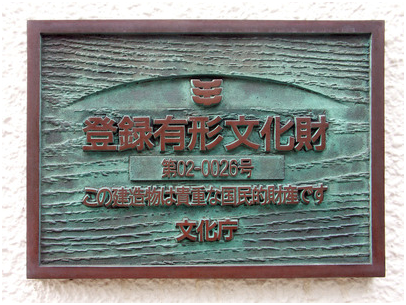
The old wing to the left of the front entrance of the museum was used as the head office of the former Aomori Bank. This was built in 1931 as a two-story reinforced concrete structure. The building is characterized by its modernist style of less of detailed decorations while leaving the structure in a classical style. It has been regarded as a typical example of the architecture of the time, and the building was registered as the national tangible cultural property (buildings) on March 4, 2004.-
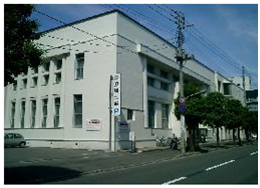
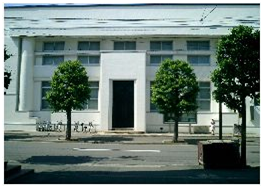
Biography and features of the building
- November 24, 1931 Completed as the Aomori branch office of the Fifty-Ninth Bank.
- October 1, 1943 Became the head office of the Aomori Bank after the merger of five banks.
- July 28, 1945 Escaped from fire even though many buildings in Aomori city were destroyed by the Aomori air raids.
- July 20, 1970 Aomori Bank Head Office was relocated to Hashimoto in Aomori City. The former head office building was donated to Aomori Prefecture.
- September 20, 1973 Aomori Prefectural Museum opened. The building has been used as a special exhibition room since then.
- *The architect of this building is Koji Horie, the seventh son of Sakichi Horie, who designed the head office of the Fifty-Ninth Bank (currently the Aomori Bank Memorial Museum in Hirosaki City, an important cultural property).
- *The number 59, which has the same industrial design as the head office of the Fifty-Ninth Bank is decorated in relief on top of the pillars and the bannister emblems in the business office (currently, the large hall).
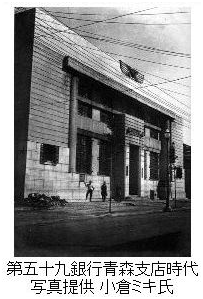
Aomori branch of the Fifty-Ninth Bank in 1931 to 1943
Photos donated by Miki Ogura
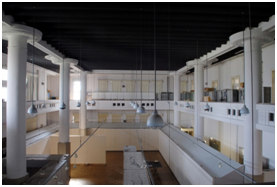
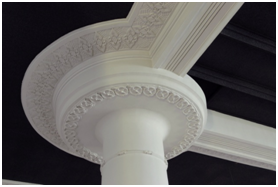
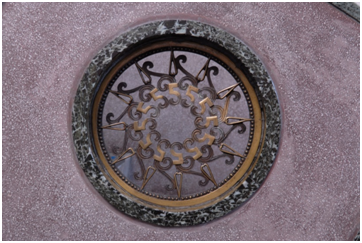
Cooperation and International Exchange
International Exchange
Russian Federation, Khabarovsk
Overview
- Joint academic research with the Khabarovsk Regional Museum
--- Outline of Exchange
Our museum and the Khabarovsk Regional Museum held special exhibitions to introduce the characteristics of the culture and region to each other in 1995 and 1997. Currently, we promote the joint academic research according to the agreement. (The current status is the third year of the second three-year agreement.)
Process of Exchange
- 1993 Sent a museum staff member to Khabarovsk for a preliminary meeting about arrangements for a special exhibition
- 1994 Sent two members of the museum staff to Khabarovsk to research a special exhibition
- 1995 Sent two and subsequently five more members, while receiving two, three, and subsequently two more members, and a special exhibition Nature and Culture of the Russian Far East was held in our museum.
- 1996 Two staff members of the Khabarovsk Regional Museum visited Aomori for research into a special exhibition
- 1997 Sent two and subsequently two more members, while receiving two, and subsequently two more members, and the special exhibition, Aomori is the Spirit of the North of Japan, was held in Khabarovsk Regional Museum.
- 1998 Concluded the agreement on joint academic research. Two people from Khabarovsk.
- 1999 Conducted joint academic research on nature (insects). Three staff members to/ from Khabarovsk.
- 2000 Conducted joint academic research on archeology (relics). Three staff members to/ from Khabarovsk.
- 2001 Conducted joint academic research on folklore (inland water fisheries). Three staff members to/ from Khabarovsk.
- 2002 Concluded the second joint academic research agreement. Sent three staff members to Khabarovsk and accepted three visitors for the first year’s research.
- 2003 Conducted a survey of the folklore study of the fishery. Three staff members to/from Khabarovsk.
- 2004 Conducted a survey of the subject of the ruins and relics in archaeological research in both Aomori and Khabarovsk. Three staff members to/ from Khabarovsk.
- July 2005 Conducted a survey of the nature based on the joint academic research agreement. Two staff members to/ from Khabarovsk.
- July 2006 Conducted a survey of the folklore based on the joint academic research agreement. Two staff members from Khabarovsk.
- 2014 Held Exchanged Photo Exhibition. In September, the Jomon Era exhibition was held in the Khabarovsk Region Museum, and Warm in North – The Evens – The People Living in Northern Russia - was held in our museum from November 2014 to February 2015.
- In 2015, both museums exchanged and displayed photos from each other's collection.
In September, Khabarovsk Regional Museum held a photo exhibition titled "UNESCO World Heritage Site Shirakami Sanchi". - In 2016, both museums exchanged and displayed photos from each other's collection.
In September, Khabarovsk Regional Museum displayed "The Takashi Tsushima Photo Collection of The Birds of Aomori"
In January, Aomori Prefectural Folk Museum featured "The Museum's Still Photos" from Khabarovsk Regional Museum.
United States, Maine
Overview
- Exchange with Maine State Museum
--- Outline of Exchange
Our museum and the Maine State Museum held special exhibitions to introduce our respective regional and cultural characteristics in 1997 and 1999. We will promote the exchange of literature and articles about each other. In addition, we will hold a small photo exhibition to display each other’s photos from time to time.
Process of Exchange
- 1996 Sent a museum staff member to a meeting about the exchange project.
- 1997 A special exhibition, Nature and Culture in Maine - Aomori and Maine Friendship Agreement Commemoration was held in our museum.
Staff members to/from Maine - 1999 A special exhibition, Aomori and Maine - Bridge beyond Time - was held in the Maine State Museum.
Staff members to/from Maine - 2000 Sent a member of the museum staff to discuss future exchange.
- 2001 Agreed to conduct academic research and send curators to each other in alternate years from 2002.
- 2002 Aborted the visit to Aomori from Maine. Secretary Level Council visited Aomori in October and agreed to review the exchange project.
- 2003 A museum staff member joined the Aomori Prefecture Secretary Level Council. They discussed future communication with the Maine State Museum in September 10.
- 2004 A special exhibition Sea and Industry in Maine was held in our museum for the 10th anniversary of the Aomori and Maine Friendship Agreement (from August 1 to 30).
- 2005 Confirmed the continuation of information and literature exchange with Maine in the meeting with the Prefecture Secretary Level Council.

